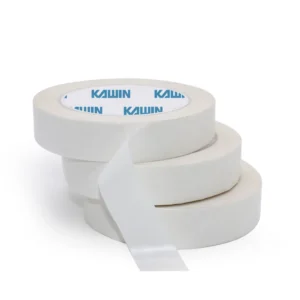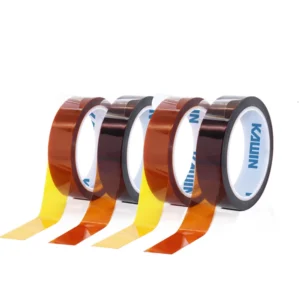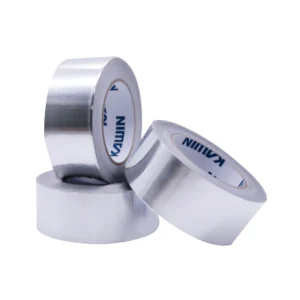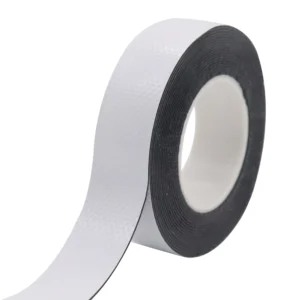n the manufacturing of Flexible Printed Circuits (FPCs) and rigid-flex boards, protecting the edges is critical. Chemical solutions from processes like plating, etching, and cleaning can easily corrode and damage board edges, leading to product failure and reduced yield. Our Margin Tape is a professional solution designed to solve this very challenge. It uses a specially formulated backing and adhesive that perfectly conforms to the circuit board edge, forming a strong “chemical barrier” that protects sensitive areas from corrosion in harsh process environments.
Core Advantages & Key Features
- Exceptional Chemical Resistance Margin tape is highly effective at resisting corrosion from acids, alkalis, plating solutions, and various chemical solvents. This ensures that the circuit board edges are reliably protected throughout the process, preventing damage caused by chemical seepage.
- Superior Adhesion and Perfect Sealing The tape’s adhesive is specially formulated for strong adhesion. When applied to FPC edges, it creates a tight, sealed line that prevents any liquid seepage, fundamentally eliminating yield issues caused by edge damage.
- Residue-Free Removal for Final Quality Despite its strong adhesion, our margin tape can be peeled off easily and cleanly after its job is done, leaving no sticky residue behind. This greatly simplifies post-processing steps and ensures the final product’s surface is clean and its electrical performance is not compromised.
- Excellent Flexibility and Workability The edges of flexible circuit boards are often irregular, requiring a tape with high conformability. Our margin tape can be easily bent and folded to perfectly conform to various complex shapes, improving operator convenience and production efficiency.
Technical Specifications
| Product Code Technical Parameters | KN2314 | KN2327 | KN2340 |
| Type | One Layer | Two Layer | Three Layer |
| Color | Yellow | Yellow | Yellow |
| Total Thickness [mm] | 0.14 | 0.27 | 0.4 |
| Backing Thickness[mm] | 0.1 | 0.23 | 0.36 |
| Backing | PET Laminated Non-Woven | PET Laminated Non-Woven | PET Laminated Non-Woven |
| Adhesive | Acrylic | Acrylic | Acrylic |
| 180°Peel Strength[N/inch] | 7.2 | 300 | 300 |
| Breakdown Voltage[KV] | ≥5.5 | ≥10 | ≥15 |
| Tensile Strength[N/10mm] | 70 | 70 | 70 |
| Elongation At Break[%] | 10 | 10 | 10 |
| Long-Term Temperature Resistance[℃] | 130 | 130 | 130 |
| Short-Term Temperature Resistance[℃] | 180 | 180 | 180 |
Typical Applications
- FPC Manufacturing: For protecting the edges and non-functional areas of circuit boards during processes like electroless copper plating, etching, and nickel-gold plating.
- Rigid-Flex Board Production: For protecting the transition area between the rigid and flexible sections of the board, preventing chemical fluid ingress.
- Circuit Board Process Masking: In any process that requires precise masking and resistance to chemical solutions.
Client Testimonials & Case Studies
“On our flexible circuit board production line, the quality of the margin tape directly determines our yield. We used to face high scrap rates due to poor tape sealing. The introduction of this margin tape completely solved the problem. It conforms perfectly to the board edges and peels off cleanly after plating, improving our product yield by over 20%.” — Process Engineer, an FPC Manufacturer
Frequently Asked Questions (FAQ)
- Q: What is the difference between margin tape and regular electrical tape? A: Their core functions are different. Margin tape is primarily for protection and sealing in chemical processes, with its design focused on chemical resistance and residue-free removal. Regular electrical tape is primarily for electrical insulation and bundling.
- Q: What chemicals is it resistant to? A: Our margin tape is resistant to common plating solutions like weak acids, weak alkalis, copper salts, and nickel salts, as well as some organic solvents. For specific chemicals, we recommend conducting a small-scale test to ensure compatibility.
- Q: Will its adhesion weaken at high temperatures? A: Our acrylic adhesive has good stability within the specified working temperature range. It maintains sufficient adhesion even at process temperatures to ensure the sealing effect.








Reviews
There are no reviews yet.